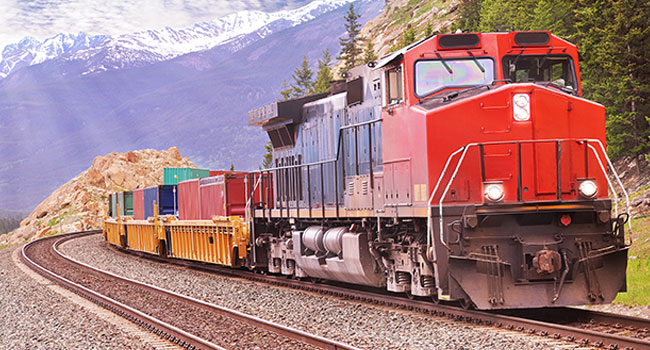
Online Exclusive: How Perimeter Security is Improving Rail Transportation Security
- By John Romanowich
- May 19, 2015
 In recent years, America’s freight railroads have been reinvesting more than ever before in infrastructure and technology to help improve transportation security. The initiatives have also been supported by the federal government through programs such as the Freight Rail Security Grant Program. Funds are allocated to freight railroad carriers that own railways in order to strengthen their ability to protect against threats, and to maintain the rail security of critical surface infrastructure such as bridges and tunnels.
In recent years, America’s freight railroads have been reinvesting more than ever before in infrastructure and technology to help improve transportation security. The initiatives have also been supported by the federal government through programs such as the Freight Rail Security Grant Program. Funds are allocated to freight railroad carriers that own railways in order to strengthen their ability to protect against threats, and to maintain the rail security of critical surface infrastructure such as bridges and tunnels.
Addressing Challenges with Smart Technology
An emerging effective and cost-efficient solution to help freight rail carriers improve security is integrated security technology including smart thermal cameras, PTZ tracking solutions and target-mapping display software. These video-based systems can automatically detect, locate and verify intrusions in real time, solving the toughest outdoor and perimeter security problems – from preventing theft and vandalism to addressing situations of national consequence.
For example, freight cars with valuable cargo are often left standing unattended at wayside locations, making them ideal targets for theft. While it is impractical to place a physical barrier like a fence directly across the operating area of a train, it is possible to place a virtual fence using smart video to detect someone entering the operational area. Upon detecting an intruder, the system determines the exact location of the intrusion and automatically zooms in on the action and tracks the intruder using PTZ cameras.
Thermal video analytic cameras represent an ideal detection source and can spot intrusions even in complete darkness, eliminating the need for illumination. Because they “see” heat, thermal cameras are perfect for detecting people; what’s more, recent advances in thermal technology now enable them to detect accurately in full sunlight as well as in complete darkness, making them a 24-hour security solution.
Smart thermal cameras which employ a high degree of image processing can amplify small differences between the temperature of an intruder and the background, accurately detecting intruders even in less than ideal conditions. Some systems use integrated GPS technology to accurately determine the size and speed of detected targets even over large distances, minimizing nuisance alerts while providing critical information about an intrusion’s location. On-board image processing is also effective in eliminating nuisance alarms caused by wind, rain, small animals and other anomalies. Additionally, these smart cameras use built-in electronic stabilization to deliver a high probability of detection without false alerts caused by vibrations from wind or train movement.
Solving Security Problems Worldwide
The United States is not alone in facing the challenges of rail security. In Italy, a major passenger rail company is using smart thermal cameras to provide rail yard security and prevent vandalism at one of the largest railcar maintenance facilities in the country. The rail organization serves more than 650,000 people every day, delivering crucial transportation services for the local financial district and the surrounding region. The company’s expansive rail yard stretches over two kilometers, encompassing an area equivalent to sixty football fields, where millions of dollars’ worth of trains are stored and serviced.
Located along a busy public highway, the rail yard was experiencing a costly and difficult security challenge. Intruders were able to gain access to the yard undetected at night and were causing severe damage to rail cars stored at the facility.
In the past, the rail company had relied on guards to patrol the large rail yard, but they continued to have ongoing vandalism problems. Finally, after a newly purchased line of rail cars was badly damaged by vandals, smart thermal cameras were installed to provide automated awareness along the 2 kilometer perimeter. When the smart camera detects an intrusion, security personnel receive an immediate alarm along with the intruder’s location pinpointed onto a topology map of the facility. For real-time visualization, PTZ cameras are automatically steered to zoom and follow the intruders, allowing security guards to quickly assess the situation. Once an alarm has been verified, local authorities are notified to respond and intervene.
The system began showing its value almost immediately; shortly after the solution was put into place, the technology detected several trespassers entering the yard. The system alerted rail security to intervene and local authorities were able to apprehend the intruders.
Cost Effective with Improved ROI
The cost to refurbish a single railroad car following an act of vandalism could be as high as $5,000 to $10,000; add to that the lost revenue when a car is out of service. Thermal cameras improve a system’s ROI by providing highly reliable real-time detection that can be used to stop an incident in progress or prevent it altogether. And because thermal cameras can often be used to cover larger areas than standard visible light cameras, system camera counts can be reduced, with the resulting lower infrastructure costs further improving the ROI equation for railway security, making thermal imaging the single most effective and cost-efficient option for providing a robust integrated security solution.
Perimeter security technology has made it possible for freight railroading to be more secure. And, while the challenge is never ending, rail carriers can be assured of a strengthened resiliency to acts of vandalism, theft and terrorism.